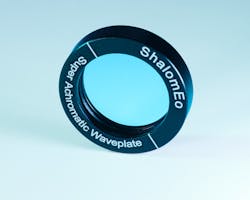Super Achromatic Waveplates
Waveplates are important laser components used to alter the polarization state of light. The altering of polarization is achieved by phase retardation between the fast and the slow components of the light beam. Waveplates made from birefringent materials realize the designed retardation values through utilizing the birefringent properties of the materials, where the birefringence causes the projected light split into two components with orthogonal oscillation directions of electric fields and different phase velocities, so that when light emerges, there will be a phase difference between the two components, causing the total vector of the light wave to change, thus manipulating the polarization state.
By fixing the value of retardation, users could obtain the anticipated effects on the polarization of light. The problem is how to stabilize the desired retardation value of a waveplate. Especially for traditional waveplates of birefringent materials (e.g Quartz), of which the refractive indices tend to be rather susceptible to change of wavelength, temperature, angle of incidence, etc, leading to fluctuations in the retardation value. The most influential factor being the wavelength, the relationship between wavelength and retardation of a birefringent waveplate could be expressed in the formula below:
Retardation=2πL(Nslow-Nfast)/λ
Where L is the thickness of the waveplate), Nfast and Nslow are the refractive indices along the fast and slow axis. When the wavelength of the incident light changes, Nslow-Nfast changes correspondingly, resulting in a change in the retardation.
For most of the ordinary low order waveplates and their advanced counterparts, zero order waveplates, the wavelength bandwidth at which the retardation could remain with no characteristic change, is poorly narrow, or even could only induce the designed retardation at one specific wavelength. To realize the application of waveplates at broadband wavelength range, one approach is to devise a waveplate constructed by two constituent waveplates of different materials, whose birefringence properties are kind of “complementary”, so that changes in retardation will be neutralized. Such waveplates are known as “Achromatic Waveplates”. The term “achromatic” refers to attenuated chromatic dispersion. This type of waveplates could significantly shrink the effect of wavelength change on retardation, subsequently expand the application spectrum to hundreds of nanometers, and could be incorporated multiple laser line sources, tunable lasers, etc.
However, with conventional achromatic waveplates of two-plate construction, the stability of retardation improved is still limited for high-end applications requiring a broader application wavelength range. To better fulfill the demands of our customers, Shalom EO recently joined the development of Super Achromatic Waveplates. Unlike conventional achromatic waveplates, super achromatic waveplates consist of six waveplates aligned together, three made from quartz (Crystalline SiO2) and three made from magnesium fluoride (MgF2). With an increased number of composing waveplates, this design minimizes the fluctuations of retardation and substantially broadens the application spectrum from the UV to the NIR. The waveplates are of cemented structure, the applied glue is an optical-grade-certified adhesive, NOA61, and the surfaces are AR coated to ensure maximum efficiency of the laser system. The retardation stability of Super Achromatic Waveplates and Achromatic Waveplates are shown below:
Figure 1. The retardation curve of a Achromatic Quarter Waveplate at 900-2000nm
Figure2. The retardation curve of a Super Achromatic Quarter Waveplate at 600-27000nm
From the graphs notice that the retardation of the super achromatic quarter waveplate only fluctuates between the 0.252 lambda and 0.248 lambda interval at the wavelength range of 600-2700nm, while the variation for the achromatic quarter waveplate is much more vigorous, curving between a larger scale between 0.26 lambda and 0.243 lambda, at the wavelength range of 900-2000nm, which is 1000nm narrower than that of the super achromatic waveplate.
The Super Achromatic Waveplates now available on Shalom EO contains four standard specifications: Quarter Waveplates at 325-1100nm and 600-2700nm, and Half Waveplates at 310-1100nm and 600-2700nm, mounted with 25.4mm anodized aluminum mounter, aperture 18mm.
Incidentally, if you are looking for retarders with an even wider application wavelength range than the super achromatic waveplates, we recommend the Fresnel Rhomb Retarders, with a maximum bandwidth of 2000-15000nm, which are also on sale on our website.


